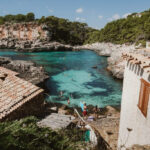Big Bend National Park, a land of stark beauty and immense scale, is nestled in the vast expanse of West Texas. For those wondering, Where Is Big Bend National Park, it’s located in the southwestern corner of Texas, bordering Mexico, and is a jewel of the Lone Star State’s park system, though often confused with its neighbor, Big Bend Ranch State Park. This comprehensive guide will help you navigate the wonders of this remote and rugged destination.
Unveiling the Location and Landscape of Big Bend
Big Bend National Park is situated within the Chihuahuan Desert, characterized by dramatic elevation changes, from the Rio Grande River at approximately 1,800 feet to the towering Chisos Mountains reaching over 7,800 feet. This geographical diversity creates a stunning array of ecosystems, from desert landscapes to riparian zones and mountain forests, all within the park’s boundaries. To pinpoint its location more precisely, Big Bend National Park is found in Brewster County, Texas, and is part of the larger Big Bend region, an area known for its isolation and breathtaking scenery.
Getting to Big Bend National Park: Navigational Tips
Reaching Big Bend National Park requires planning due to its remote location. The closest major airport is Midland International Air and Space Port (MAF), approximately a 3-hour drive away. El Paso International Airport (ELP) is another option, roughly a 4.5-hour drive. From either airport, you’ll embark on a scenic drive through West Texas, eventually leading you to the park’s entrances. It’s crucial to note that once inside the park, distances are vast, and driving times can be longer than anticipated due to road conditions and speed limits.
Exploring Big Bend: Activities and Adventures
Big Bend National Park is an outdoor enthusiast’s paradise, offering a plethora of activities to suit every interest:
- Hiking: With over 150 miles of trails, hiking is a premier activity. Trails range from easy strolls along the Rio Grande to strenuous climbs in the Chisos Mountains. Popular trails include the Lost Mine Trail, Window View Trail, and the challenging South Rim Trail.
- Camping: Experience the solitude of the desert night sky by camping in one of the park’s campgrounds. Reservations are highly recommended, especially during peak season. Backcountry camping is also available with a permit.
- River Activities: The Rio Grande offers opportunities for canoeing and kayaking. Guided river trips are available for those seeking a more structured experience.
- Scenic Drives: Explore the park’s diverse landscapes via scenic drives like the Ross Maxwell Scenic Drive, offering panoramic views and access to trailheads and historical sites.
- Stargazing: Big Bend is renowned as an International Dark Sky Park, offering unparalleled stargazing opportunities. Join ranger programs or simply gaze upwards on a clear night to witness the Milky Way in all its glory.
Essential Tips for Visiting Big Bend National Park
- Prepare for Extreme Weather: Big Bend experiences extreme temperatures, especially during summer. Heat can be intense, and temperatures can fluctuate dramatically between day and night. Always carry plenty of water, wear sun protection, and be aware of weather conditions.
- Vehicle Readiness: While most park roads are paved and accessible to standard vehicles, some areas, particularly in Big Bend Ranch State Park adjacent to the National Park, require high-clearance or four-wheel-drive vehicles. Check park road conditions before venturing out.
- Stay Connected (or Disconnected): Cell service is extremely limited within Big Bend National Park. Be prepared to be off the grid. Download maps and information beforehand, and inform someone of your itinerary.
- Reservations and Permits: Reservations are essential for camping and recommended for popular activities, especially during peak seasons. Permits are required for backcountry camping and river use.
- Respect the Environment: Big Bend is a fragile desert ecosystem. Stay on marked trails, pack out all trash, and respect wildlife.
Big Bend National Park vs. Big Bend Ranch State Park: Understanding the Difference
It’s important to distinguish between Big Bend National Park and Big Bend Ranch State Park. While both are located in the Big Bend region and offer incredible outdoor experiences, they are separate entities with different management and characteristics. Big Bend National Park is federally managed and known for its iconic Chisos Mountains and established infrastructure. Big Bend Ranch State Park, often referred to as “Texas’s Other National Park,” is state-managed and emphasizes a more rugged, less developed wilderness experience, requiring more self-sufficiency from visitors. The State Park, as mentioned in the original article, is indeed for the “truly adventurous” seeking a more remote experience.
Beyond Big Bend: Nearby Attractions
Extend your Big Bend adventure by exploring nearby attractions:
- Big Bend Ranch State Park: For an even more remote and rugged experience, explore Texas’s largest state park.
- Terlingua Ghost Town: Experience the quirky and historic ghost town of Terlingua, near the park’s western entrance.
- Marfa: Visit the art-centric town of Marfa, known for its minimalist art installations and the mysterious Marfa Lights.
- McDonald Observatory: Located near Fort Davis, this observatory offers public star parties and solar viewings.
- Fort Davis National Historic Site & Davis Mountains State Park: Explore the history and natural beauty of the Davis Mountains region.
Conclusion: Your Journey to Big Bend Awaits
Understanding where is Big Bend National Park is just the first step in planning an unforgettable journey to this extraordinary corner of Texas. Whether you’re drawn by hiking trails, river adventures, dark night skies, or the stark beauty of the desert, Big Bend National Park promises an experience unlike any other. Prepare for an adventure, embrace the remoteness, and discover the magic of Big Bend.

